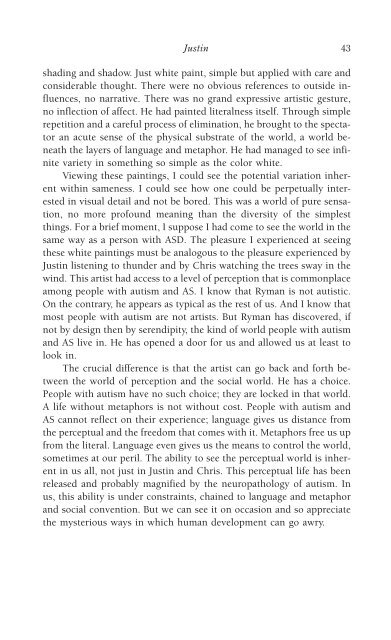978-1572305441
autism
autism
Create successful ePaper yourself
Turn your PDF publications into a flip-book with our unique Google optimized e-Paper software.
Justin 43<br />
shading and shadow. Just white paint, simple but applied with care and<br />
considerable thought. There were no obvious references to outside influences,<br />
no narrative. There was no grand expressive artistic gesture,<br />
no inflection of affect. He had painted literalness itself. Through simple<br />
repetition and a careful process of elimination, he brought to the spectator<br />
an acute sense of the physical substrate of the world, a world beneath<br />
the layers of language and metaphor. He had managed to see infinite<br />
variety in something so simple as the color white.<br />
Viewing these paintings, I could see the potential variation inherent<br />
within sameness. I could see how one could be perpetually interested<br />
in visual detail and not be bored. This was a world of pure sensation,<br />
no more profound meaning than the diversity of the simplest<br />
things. For a brief moment, I suppose I had come to see the world in the<br />
same way as a person with ASD. The pleasure I experienced at seeing<br />
these white paintings must be analogous to the pleasure experienced by<br />
Justin listening to thunder and by Chris watching the trees sway in the<br />
wind. This artist had access to a level of perception that is commonplace<br />
among people with autism and AS. I know that Ryman is not autistic.<br />
On the contrary, he appears as typical as the rest of us. And I know that<br />
most people with autism are not artists. But Ryman has discovered, if<br />
not by design then by serendipity, the kind of world people with autism<br />
and AS live in. He has opened a door for us and allowed us at least to<br />
look in.<br />
The crucial difference is that the artist can go back and forth between<br />
the world of perception and the social world. He has a choice.<br />
People with autism have no such choice; they are locked in that world.<br />
A life without metaphors is not without cost. People with autism and<br />
AS cannot reflect on their experience; language gives us distance from<br />
the perceptual and the freedom that comes with it. Metaphors free us up<br />
from the literal. Language even gives us the means to control the world,<br />
sometimes at our peril. The ability to see the perceptual world is inherent<br />
in us all, not just in Justin and Chris. This perceptual life has been<br />
released and probably magnified by the neuropathology of autism. In<br />
us, this ability is under constraints, chained to language and metaphor<br />
and social convention. But we can see it on occasion and so appreciate<br />
the mysterious ways in which human development can go awry.



